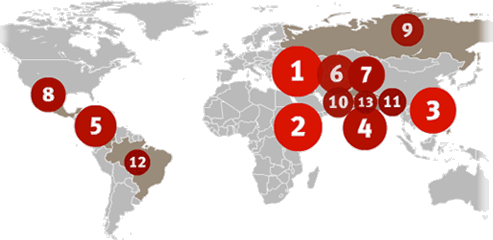Despite high levels of press and Internet freedom, provincial journalists worked under constant threat of reprisal. Two broadcast journalists, Gerardo Ortega and Romeo Olea, were shot and killed for their reporting. Both cases were unsolved by year’s end, underscoring the country’s third worst ranking on CPJ’s 2011 Impunity Index, which calculates unsolved journalist murders as a percentage of a country’s population. The vow of President Benigno S. Aquino III to reverse the trend went unfulfilled as legal proceedings in the 2009 Maguindanao massacre, in which 32 media workers were ambushed and slain, stalled amid numerous defense motions to disqualify witnesses and suppress outside scrutiny. In another high-profile case, an appeals court denied a dismissal motion filed by two government officials accused of plotting the 2005 murder of reporter Marlene Garcia-Esperat. Although the decision cleared the way for arrests, the long-running prosecution has been beset by delays. Press advocates were critical of a new freedom of information bill, which they said would curtail access to official documents.
Philippines
» Prosecution stalls in landmark Maguindanao massacre case.
» Provincial journalists face persistent violence; two murders reported.
Despite high levels of press and Internet freedom, provincial journalists worked under constant threat of reprisal. Two broadcast journalists, Gerardo Ortega and Romeo Olea, were shot and killed for their reporting. Both cases were unsolved by year’s end, underscoring the country’s third worst ranking on CPJ’s 2011 Impunity Index, which calculates unsolved journalist murders as a percentage of a country’s population. The vow of President Benigno S. Aquino III to reverse the trend went unfulfilled as legal proceedings in the 2009 Maguindanao massacre, in which 32 media workers were ambushed and slain, stalled amid numerous defense motions to disqualify witnesses and suppress outside scrutiny. In another high-profile case, an appeals court denied a dismissal motion filed by two government officials accused of plotting the 2005 murder of reporter Marlene Garcia-Esperat. Although the decision cleared the way for arrests, the long-running prosecution has been beset by delays. Press advocates were critical of a new freedom of information bill, which they said would curtail access to official documents.
Analysis: Undue Process in Maguindanao Massacre Trial
Nearly two years since 32 journalists were murdered, the fight for justice has both intensified in rhetoric and bogged down in technicalities. Without a greater commitment of resources, the litmus test is one the Philippines could fail. Analysis by Shawn W. Crispin
-
3rd
Impunity Index rating -
2
Killed in 2011 -
2nd
Deadliest country -
25%
Internet penetration, 2010 -
8th
Highest Facebook use
At least 56 journalist murders have gone unsolved over the past decade, making the Philippines the world's third worst nation in bringing the perpetrators of media killings to justice, CPJ's Impunity Index shows.

| 1. Iraq 2. Somalia 3. Philippines 4. Sri Lanka | 5. Colombia 6. Afghanistan 7. Nepal 8. Mexico | 9. Russia 10. Pakistan 11. Bangladesh 12. Brazil | 13. India |
Two radio journalists were killed in direct relation to their reporting in 2011, according to CPJ research. Half of the 72 Philippine journalists killed since 1992 worked in radio, CPJ data show. The 2011 killings add to the country's long record of deadly anti-press violence.
At least 72 journalists have been killed for their work since 1992, making the Philippines the second deadliest country in the world for journalists, CPJ research shows. Fatalities include murders, along with deaths on dangerous assignments.
1. Iraq: 151
2: Philippines: 72
3: Algeria: 60
4: Russia: 53
5: Colombia: 43
6: Pakistan: 41
7: Somalia: 36
8: India: 27
9: Mexico: 27
10: Afghanistan: 24
With its far-flung island geography and underdeveloped landline systems, Internet penetration has lagged behind several of the country's Asian neighbors, according to data compiled by the International Telecommunication Union, or ITU.
Although the country has lagged in Internet penetration, its residents have quickly adopted social media platforms. The Philippines ranks among the world's top 10 in total Facebook users, according to social media statistics aggregator Socialbakers.
Top 10 in Facebook use as of November 1, 2011:
1. United States: 156 million
2. Indonesia: 40.8 million
3. India: 38 million
4. United Kingdom: 30.5 million
5. Turkey: 30.4 million
6. Brazil: 30.4 million
7. Mexico: 30.1 million
8. Philippines: 26.7 million
9. France: 23.2 million
10. Germany: 21.6 million
